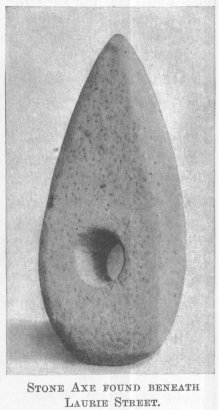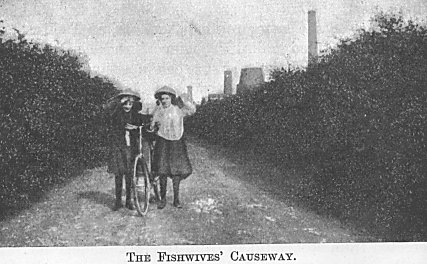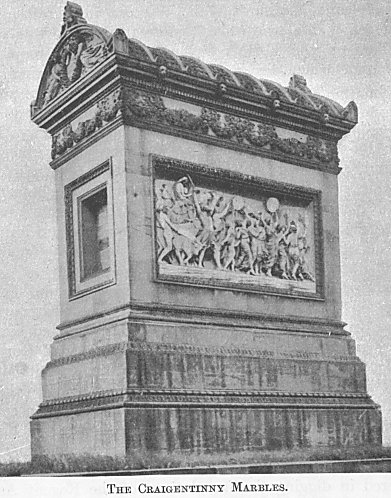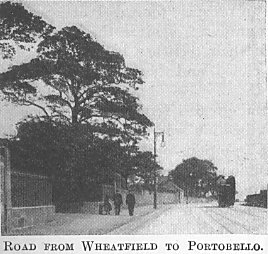|
THE story of some of our
Scottish towns is comparatively easy to write because they have their
origin in modern times, and consequently the records of their history are
usually both full and complete. But Leith is not one of these towns. It is
a town of ancient origin, its beginnings taking us far back into the years
of past time, and its story, in the earlier years of its history, has to
be laboriously sought in many an old charter or other document.
From these documents we
learn that as far back as eight hundred years ago Leith was a thriving
village. Its houses nestled along the mouth of the Water of Leith, just
where the Shore now stands. Unfortunately, we know very little of this old
village, for it never entered into the thoughts of the monks—who were
the only chroniclers of those days—that future generations would be
interested in knowing something of the Leith of their days and the life of
its inhabitants. The information they give us is scanty in the extreme,
and thus it is exceedingly difficult to form a clear mental picture of
this Leith of other days.
Of one thing we may be sure: fishing would be the chief
occupation of the people of the village. And of one other thing we can be
equally certain, and that is that the date of the foundation of Leith,
could we but get it, would be found to be much further back than the
twelfth century. In our own days we read of cities springing up in a
single night, like Jonah’s gourd, but in those days towns and villages
developed very slowly. There was then no such thing among them as
"mushroom growth." They grew in size only by slow degrees; and
so, if Leith was an important place eight hundred years ago—important,
that is, according to the ideas of those times—its history must have
begun at a much earlier date. But there are no records of. Leith which go
back further than 1143, and there is no likelihood of any such ever being
discovered.
If Leith, then, dates so far back into olden times, you
may be tempted to ask why the Leith of to-day contains so very few really
old houses. The reasons are not far to seek. Leith’s history is not only
interesting but it is also eventful. Its history has often been of much
more than local note, and on more than one occasion the fortunes of Leith
have been the point on which the whole history of our country has turned.
This was especially so, as we shall see, in the days of Queen Mary. Now a
town cannot hope to bear the brunt in troublous times and escape
unscathed. Leith has often had to pay a heavy penalty for its share in
Scotland’s history. For example, when the Earl of Hertford led an
invading force into Scotland because the Scots had rejected the contract
of marriage between the English Prince Edward and the young Mary Queen of
Scots, Henry VIII. ordered him to burn Leith, and, if necessity required
it, to massacre its inhabitants. Hertford faithfully carried out the first
part of his instructions. Having possessed himself of Leith, he destroyed
the pier, and then proceeded to set fire to the town, reducing to ruins as
much of it as he possibly could. It is small wonder that Leith to-day
contains so few old houses.
Then, again, in modern times the magistrates of Leith
have carried through many improvement schemes, and this has meant the
sweeping away, not of single houses, but of whole streets. While we are
glad that light and air have been let into districts sorely in need of
them, yet we cannot but regret the disappearance of many of Leith’s
old-time houses. But though the houses themselves have passed out of
existence their sites can still be pointed out, and we still have pictures
of many of them. Some of these are shown in this book.
It has already been said that Leith existed as a
village more than eight hundred years ago. But there is a question to ask
which carries us very much further back in time than eight hundred years.
It takes us back to prehistoric times, times of which there is no written
history, because the rude, uncivilized people of those days could, of
course, neither read nor write. The question is this : When did man first
make his appearance in the district on which modern Leith now stands?
To this question nothing like a definite answer can be
given, but learned men who have made a special study of prehistoric
Scotland tell us that many thousand years must have elapsed since man
first appeared on the scene in our country. These archaeologists, as we
call them, are not agreed among themselves as to the age in which Scotland
became the scene of human habitation; and this is not to be wondered at,
as the evidence on this question must be got from unwritten and not
from written history, and naturally each archaeologist places his
own interpretation upon this evidence. But they all agree that it must
have been many thousands of years before the Christian era that man made
his appearance in our land.
 By
using your imagination, try to picture how the area on which Leith stands
would look in those far-off and so very different times. Imagine the
disappearance of every building in Leith, of all its busy streets and
still busier docks, and then imagine the whole district covered with great
forests, the home of wild beasts such as the fox and the wild cat, and
other animals which have long been extinct in Scotland, as the wild boar,
the beaver, and the wolf. Imagine the sweep of the forests broken here and
there by a loch or marshy piece of ground, for there were innumerable
lakes, marshes, bogs, and morasses all over the low ground of our country
in those days. The Water of Leith would form part of the picture of your
mind’s eye, for, of course, then as now it journeyed on from its source
among the hills to where its waters mingled with those of the sea. But
gone would be the solid stone quays which now confine its course. Your
picture would show it turning and twining in its bed between its own
natural tree-clad banks, its clear-running water sparkling in the
sunshine. By
using your imagination, try to picture how the area on which Leith stands
would look in those far-off and so very different times. Imagine the
disappearance of every building in Leith, of all its busy streets and
still busier docks, and then imagine the whole district covered with great
forests, the home of wild beasts such as the fox and the wild cat, and
other animals which have long been extinct in Scotland, as the wild boar,
the beaver, and the wolf. Imagine the sweep of the forests broken here and
there by a loch or marshy piece of ground, for there were innumerable
lakes, marshes, bogs, and morasses all over the low ground of our country
in those days. The Water of Leith would form part of the picture of your
mind’s eye, for, of course, then as now it journeyed on from its source
among the hills to where its waters mingled with those of the sea. But
gone would be the solid stone quays which now confine its course. Your
picture would show it turning and twining in its bed between its own
natural tree-clad banks, its clear-running water sparkling in the
sunshine.
Although we cannot say with any degree of certainty
exactly when man first appeared on such a scene as you have just depicted
to yourself, we can be pretty certain that the district on which Leith
stands began to he populated before the land on which Edinburgh is built.
The ground on which Edinburgh now stands is higher than
that which lies between it and the sea, and would therefore afford more
security against the attacks of wild beasts and neighbouring tribes. But
to the uncivilized man of that time this advantage was more than
counterbalanced by other considerations. In the first place, the dense
forests would offer him little temptation to penetrate inland; and then,
also he would want to live as near as he could to the sea which provided
him with fish, and along the shores of which at ebb-tide he gathered the
limpets, mussels, and cockles which formed so large a part of his diet.
These first forefathers of ours lived in rudely
constructed dwellings, clothed themselves in skins, and lived on the
produce of the sea and such animals as they were able to kill in the
forests. They did not know the use of metals. Their implements and weapons
were made of stone, bone, horn, or wood. As time went on they gradually
became less barbaric. Their stone implements became more finely and more
symmetrically worked. Then a discovery was made which lifted the
prehistoric peoples into a higher stage of culture and civilization. This
discovery was the art of making bronze.
 Lastly,
just as stone gave way to bronze, so bronze in its turn was superseded by
iron. When the use of iron was discovered, tools could be made which were
far superior to those made of bronze, just as bronze tools had been far
superior to those made of stone. As you doubtless already know, these
three periods in our history are known as the Stone, Bronze, and Iron
Ages. Lastly,
just as stone gave way to bronze, so bronze in its turn was superseded by
iron. When the use of iron was discovered, tools could be made which were
far superior to those made of bronze, just as bronze tools had been far
superior to those made of stone. As you doubtless already know, these
three periods in our history are known as the Stone, Bronze, and Iron
Ages.
None of the dwellings of these old peoples are known to
have been discovered on the site on which Leith stands. This is not to be
wondered at, since they were made, not of stone, but of timber, which must
have decayed long ago. We cannot even find traces of their existence,
because these have been obliterated by the cultivation of the land before
a town came to be built on it. But the skulls of these early inhabitants
have been found, as also some of their wedge-shaped stone hammers and axes
of bronze.
You will find some of these in the Antiquarian Museum
in Queen Street, Edinburgh, a building which you ought to visit if you are
interested in prehistoric Scotland. In it you will see a very large
collection of articles belonging to prehistoric ages which have been
discovered at various times in different parts of Scotland. These have
been systematically arranged so that the visitor may trace the successive
changes in the life of prehistoric man and his gradual progress in
civilization. You will be especially interested in searching out the
objects which have been contributed from Leith.
To sum up the progress made from the first human
occupation of the site of Leith, we may say that at the beginning of the
Christian era prehistoric man had left much of his savagedom behind him.
He had begun to grow corn; he was in possession of domestic animals—the
horse, dog, ox, sheep, and goat; he had implements of iron, and he showed
considerable mechanical skill in various directions.
The materials of unwritten history are to be found in
caves, rock shelters, and underground dwellings, in river beds, in drained
lochs, in hill forts, and in the memorials erected to their dead by the
prehistoric races. With the coming of the Romans to Scotland in A.D.
80 we emerge from the period of unwritten history. Our knowledge of
the history of Leith will henceforward be obtained from books, and from
written records and documents.
For our knowledge of the Roman campaigns in Scotland we
have to depend largely, though not altogether, upon the materials of
unwritten history, and to gather their story from the remains the Romans
left behind them—their camps and their forts, and the objects lying
buried there beneath the surface. From these, and the story they reveal to
men skilled in their interpretation, we obtain much knowledge of the Roman
occupation of our district.
It was Julius Agricola who first led the Romans into
North Britain and brought them right into our neighbourhood. From the
south he made his way through the heart of the Cheviots, and, crossing the
river Tweed at Newstead, near Melrose, continued his march until he came
to the Lammermuir Hills. Along the line of his route he built forts at
strategic points like New-stead, and to overawe the natives he laid waste
the land as he advanced.
The news of the slow but steady advance of the
seemingly invincible enemy would reach the people of our district long
before the Romans themselves appeared. From vantage points on the Calton
Hill and Arthur Seat their scouts would be keenly watchful, ready to give
the alarm on the first appearance of the glittering spears and helmets of
the Roman legions. They would be in readiness to seek refuge within the
recesses of the deep forests, or to betake themselves to strongholds on
the lower hill-tops, like the fort on the rocky height overlooking
Dunsappie Loch, from which they could watch the movements of the invader
and find a safe retreat from his devastating legions.
Having crossed the Lammermuirs by the pass at Soutra,
Agricola had then to determine his further line of march. His aim was to
reach the central district of the Lowlands of Scotland—that is, the
country between the Firth of Forth and the Firth of Clyde. He had a choice
between two routes. From Soutra he could march almost due west. This would
be his most direct route but if he took it he would have to cross the
valleys of the North Esk and the South Esk, and the Pentland Hills would
also form another obstacle. On the other hand, an easy march of ten miles
from Soutra in a northwesterly direction would bring him to the shores of
the Firth of Forth at the mouth of the Esk, from which point his march
along the coast plain would present few difficulties.
He chose the latter route. Agricola, as Tacitus tells
us, was a skilled military engineer, and his quick eye at once perceived
the fine strategic position of Inveresk, protected as it was on west and
south by the great Caledonian Forest, and safe from attack on the east by
Pinkie Cleuch. It commanded all the routes from the south and east going
westwards towards the Clyde. Many remains of the great fort built by the
Romans at Inveresk are still to be seen, including the heating chambers of
their baths, while Inveresk Church and numerous other buildings near it
have probably been erected from stones taken from the fort.
Leaving a garrison behind him, and crossing the Esk by
a wooden bridge—the present so-called Roman Bridge not being built until
many centuries later—Agricola marched westward by way of Restalrig to
the country between the Forth and Clyde, his military way passing right
through our parish. Whether there was any hamlet or village of the Britons
where Leith now stands we have no means of knowing; but as our district is
the meeting place of routes by road from the south, east, and west, it
must have been a centre of traffic for the population in forest clearings
and along the shore of the Forth.

At the west end of Portobello there is a road of Roman
origin, known to-day as the Fishwives’ Causeway, though, of course, it
would not be so named in Roman times. This ancient road has for many long
years formed part of the boundary between the parishes of Duddingston and
South Leith. It is called a causeway because it was a causewayed road, as
all Roman roads were, its stones being mostly boulders from the seashore
close at hand, and quite undressed by the Roman work-men who laid them.
When the present Portobello Road was made about 1770, the fishwives of
Fisherrow, on their way to Edinburgh to dispose of their fish, continued
to favour the old causewayed road in preference to the new; hence the name
Fishwives’ Causeway. It is a causeway no longer, its stones having been
lifted and utilized in the construction of the great wall enclosing the
Craigentinny parks on the left side of the turnpike road from Wheatfield
to Portobello, where their round boulder shape at once betrays them.
In the year 180 the hated Romans were driven south of
the Cheviots. Yet Leith had not seen the last of the Roman legions, for in
the year 208 the great soldier emperor, Severus, set sail from York for
the Forth with a mighty fleet to punish the wild Caledonians for their
raids beyond Hadrian’s Wall. We can imagine the excitement and alarm
when the great armada was seen heading up the Forth. Severus landed his
troops at Cramond, which became his headquarters during his three years’
stay in Scotland; and there, as at Inveresk, you may see stones showing
Roman handiwork and an eagle that some Roman soldier with an artistic eye
has carved on the Eagle Rock by the shore. Severus was to find, as Edward
I. centuries later, that to win victories is not to conquer a country,
and, when he sailed from Cramond on his return to York, the Roman capital
of Britain, the shores of the Forth saw the Roman legions for the last
time.
The many chance finds of Roman relics that have been
made within the bounds of Edinburgh and Leith have led to the belief that
a Roman post midway between Inveresk and Cramond must have existed
somewhere in our neighbourhood. The discovery of Roman bricks from time to
time in the foundations of St. Margaret’s Chapel in Edinburgh Castle has
led some to think that a Roman station once existed there. Roman coins
have been found at several points, including the Fishwives Causeway and
Leith Walk, and a rich find of Samian ware—the best china of the Romans—was
uncovered in digging the foundations of the Regent Arch in the landward
part of our parish. Such discoveries do not necessarily indicate a Roman
settlement, for such chance finds occur in all parts of Scotland, and even
in countries the Romans never knew. They are rather a proof that during
the Roman occupation much commercial intercourse grew up between the
Britons and their conquerors, and that this trade continued long after the
Roman legions had retired beyond the wall of Hadrian.

The Romans used to bury their dead in tombs ranged along the sides of
the roads outside their cities—the strip of ground on each side being
laid out much after the manner of our cemeteries. The famous Appian Way,
the great road that led southwards from ancient Rome, is flanked on both
sides for many miles with handsome tombs. Though Roman tombstones have
been discovered in other parts of Scotland, none has so far been found in
our neighbourhood. By a strange chance, however, one may see a great
sepulchral monument, designed from a tomb on the Appian Way, standing
solitary and alone in one of the Craigentinny parks close by the Fishwives’
Causeway, and just within the ancient parishes of South Leith and
Restalrig. This is the tomb of William Henry Miller of Craigentinny, who
wished to be buried in one of his own fields. It is ornamented with two
beautifully sculptured marble panels, known to fame as the "Craigentinny
Marbles." It is a strange coincidence indeed that full sixteen
centuries after the Romans left our district there should have been
erected directly on the Roman road a tomb so purely Roman in its design as
that which we have at Craigentinny.

|

